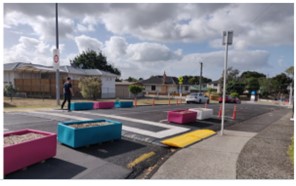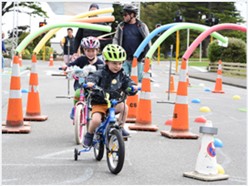Frequently Asked Questions
This project is part of the Streets for People initiative funded and supported by Waka Kotahi NZ Transport Agency. The aim of the project is to try out temporary changes to make a safer and more people friendly connection for active and low carbon of transport between the Wainuiomata town centre, local schools and Te Hikoi Ararewa (Wainuiomata Hill Shared Path).
We want it to feel safe and inviting for residents of all ages to walk, skate, scooter or bike to school, work and the Town Centre, and to spend time in public spaces like the Town Centre.
This might mean safer crossings near schools, lower vehicle speeds in the project area, more seating or more accessible ramps or other changes.
Hutt City Council applied for the Waka Kotahi Streets for People funding as it creates new opportunities to partner with communities and businesses to make our streets and public spaces safer and more enjoyable to spend time in.
The fund provides councils with the financial resource and expert support to meaningfully partner and try out temporary changes that make it easier for people to move around or access community spaces. 90% of the project budget is provided by Waka Kotahi with the remaining 10% funded by Hutt City Council through existing budget allocations.
Along with the financial resource, the project teams are able to call on support from local and international experts who have delivered projects with similar aims, as well as learning from the other communities and councils that have also been funded for projects through the Streets for People initiative.
Wainuiomata is a fast-growing suburb that occupies a flat valley with a warmer and less windy climate than the rest of Lower Hutt. It has excellent facilities for recreational biking and walking (Waiu Park, BMX facilities, Heartland Ride), the popular Te Hikoi Ararewa (Wainuiomata Shared Path) and major upgrades to the Town Centre are almost complete. There are several local schools serving the community and most are interested in active travel with their school biking and scooter programs. There are also two retirement homes with some residents who no longer drive. Wainuiomata has some excellent of-road paths that are suitable for its oldest and youngest residents to walk or scooter along for independent travel.
Traffic safety concerns and a lack of connections to these shared paths are seen as barriers preventing people from walking, biking or scootering for more of their daily journeys to school or to the town centre. These issues were identified by the public in surveys for the Wainuiomata Town Centre Upgrade.
In addition to the work improving the town centre, this central area is ideal to trial change as there are three primary schools and one secondary school in the area. These schools are attended by 1,300 students. Being a passenger in a private car is a main way for many of them to get to school, which means a lot of congestion along Konini Street in particular. This congestion makes it less safe or attractive for others to walk, scoot or bike to school. A lot of work has been done to ensure students learn cycle safety and scooter safety skills at all Lower Hutt primary schools. A safe, accessible and attractive route with more crossings will enable students from these schools to put their skills into action and increase the number of students getting to school actively and reduce the amount of traffic in the area as a result. If it is safe and works well for primary aged students, then it will be safe and work well for all users. Fewer short local trips by car helps families to save money on petrol, is healthier for our people and our planet, and means that our youngest and oldest residents can be more independent.
Nationally there is a goal to increase the proportion of journeys made using active and public transport by 40% by 2030. This goal helps us to meet our carbon emission goals, improve health, and optimise the efficiency of the existing network. The increasing popularity of electric bikes and scooters will help to meet this goal by making active transport more accessible to more people and enabling people to travel more quickly.
The increasingly connected network of cycleways and shared paths across Lower Hutt means over time more people will feel safer using active modes of transport to get around Lower Hutt.
The funding for these projects comes from Waka Kotahi’s Innovating Streets for People fund. Waka Kotahi provides 90% of the funding for the project and Hutt City Council provides the remaining 10% from existing budgets.
Tactical urbanism is all about action and real-world trials. It allows community and Council to work together to quickly design and test changes to local roads and community spaces that will make them more people-friendly. These changes can then be tested in the real world by the people who use the space. Trial layouts can be adapted in response to data and feedback. It means that when a final layout is arrived at, Council and community can have confidence that it will work well for all users of a road or public space and deliver safer, more attractive journeys and spaces. It features the following characteristics:
- A deliberate, phased, iterative approach to making changes;
- The offering of local solutions for local planning challenges;
- Short-term commitment as a first step towards longer-term changes;
- Low cost
- Developing connections between community members and engaging and empowering communities to work with local authorities to bring positive changes.
The key to the success of this type of project is to listen and work with local communities to design solutions that meet their needs and ambitions.
The projects are about temporarily trialling new layouts in order to find something that works better for people than the current layout. We want the journeys for people on scooters, wheelchairs, walking or on bikes to and from the town centre to be easier and more accessible.
New layouts can be tested quickly and adapted in response to feedback. Temporary changes that make crossing the road easier and slow traffic using planter barriers, artwork, temporary chicanes or paint are possible. Changes to parking layout, installation of more clear signage and wayfinding or temporary bike and scooter parking are all options.
The great thing about these projects is that they will be designed alongside schools, businesses, residents and community. Trials will determine whether the changes make the journey better and safer for people walking, scootering, biking or using other active modes. Permanent change including concreting and roadworks is outside of the scope of these projects, but a temporary layout that works well for community could be made permanent in future.
How long changes are in place will depend on how well they work for people. The first trials will be pop-up installations of up to one week to test layouts. These will be on-road physical installations put in place under temporary traffic management for up to one week. These allow community to experience new layouts and give feedback in real time. They can be adjusted in response to feedback. Treatments that can be tested with pop-up layouts include build outs to improve the safety and ease of crossing the road for pedestrians, temporary crossings, temporary cycle lanes.
Example of trial build outs at a pedestrian crossing |
Example of a pop-up event. Photo credit: Invercargill City Council |
Interim layout, photo credit: Christchurch City Council |
Example of an interim layout. Photo credit: Waka Kotahi |
The fund provides the opportunity to test a new approach to designing and trialling changes to streets and public spaces. Temporary changes are used because they are low cost and adaptable. This means we can get feedback and monitor changes in real time and make any changes or adaptations needed. What we learn from temporary projects can then inform longer term decisions.
Temporary trials are a timely and cost-effective way of testing out solutions. By testing temporary solutions, we can adapt and change the layout to get the best solution for the people who use the street. We aim to use temporary solutions that can be reused and/or recycled for maximum sustainability and value for money.
Hutt City Council’s Integrated Transport Strategy sets out a vision and roadmap for the future of Lower Hutt’s transport system.
Council has worked closely with our local community, Mana whenua and key stakeholders to understand transport challenges and priorities of our residents when moving around our city. The Integrated Transport Strategy was developed to guide future planning, investments and deliver a healthy, safe, and resilient transport system. Three relevant focus areas of the ITS for achieving this vision are:
- Creating a connected and safe travel network that makes it more attractive for people to cycle, walk or use the bus
- Create people-focussed, liveable streets around key transport hubs and local centres
- Encourage people to rethink how and when they travel
We need to reduce our transport emissions to help manage the effect of climate change and meet Aotearoa’s global obligations. The Government’s National Emission Reduction Plan (ERP) identifies interventions and sets targets to reduce greenhouse gas emissions, with the objective of reducing vehicle kilometres travelled (VKT) by 20% by 2035. To achieve this, we need more people to choose active and low carbon modes of transport for their short, local daily journeys more often.
We need feedback from all the people who use the area to understand their experience of the trial layouts. This feedback along with real time traffic monitoring will help determine what happens next in the project.
All the elements of the trial are temporary so can be changed and adapted as needed. We encourage as many people as possible to try out the temporary changes and provide their feedback to help the decision-making process. We’ll share ways for you to do that closer to the time. Sign up for the newsletter to stay in the know.



